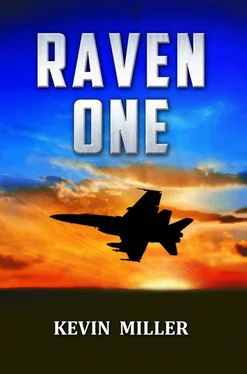Holy shiiiit!
Wilson kicked right rudder to slide closer and jam any chance for a bandit gunshot. When the bandit pulled all the way over, almost on its back but in control, he cursed in frustration at what he knew was coming next. The hostile fighter reversed over the top in a negative g maneuver, his nose tracking down on Wilson like a falling sledgehammer in slow motion. Horrified, Wilson realized he faced an imminent snapshot. With the little air speed he had, he inverted his Hornet to avoid it. His aircraft still rolling, Wilson saw that the monster had another weapon at its disposal. Thrust vectoring!
Wilson managed to float, barely in control, in front of the bandit. Shocked at the gaping maw of the intake only 200 feet away, Wilson, upside down, looked out his left side. At that moment, the right side of the Iranian’s fuselage unleashed a bright tongue of flame. Inside the flame was a nearly solid stream of what looked like flaming supersonic baseballs. Under Wilson, an earsplitting POP-POP-POP-POP-POP penetrated the canopy. A low guttural BORRRRP sounded in the background as the cannon rounds missed low, mere feet from his head.
Mo -ther-FUUUCK!” he cried into his mask.
Petrified, Wilson pulled hard and down, rolling and kicking the controls to the left. Straining to keep sight of the bandit hovering above him, Wilson saw the nose of the fighter drop to pounce once again. He let out an involuntary whimper of fear as he slammed the stick forward to unload. In the back of his mind he acknowledged his cry and recognized it as a signal of the panic that he must fight in addition to his adversary. Over the years, Wilson had known apprehension and fear. Taxiing to the bow on a pitch-black night. Caught inside a thunderstorm. Far from land trying to find a tanker at night in bad weather with low fuel. He had been afraid before and knew how to handle it through compartmentalization and preflight preparation. But this was different.
Twenty minutes earlier Prince’s poor navigation had been Wilson’s biggest problem. Then Prince had been blown out of the sky right next to him, and now Wilson was unarmed over a hostile country fighting an unknown aircraft with a pilot who was trying to kill him. Those flaming balls represented a stream of death that had just passed underneath him by mere feet. That stream, delivered by a thinking human, was about to reach out to him again in seconds. This realization was more than fear; it was terror.
Get down, Wilson thought.
He had two immediate and conflicting needs. First, he had to stay out of the Iranian’s gunsight by maneuvering hard once he felt threatened, although that bled air speed. His second need was to get into the weeds. To do that he had to regain maneuvering air speed at the cost of providing the bandit with a predictable flight path, one that would almost surely invite a missile or a gunshot.
Wilson’s senses were on fire. With his neck stretched back as far as possible to keep sight, he flew the aircraft by feel. The big fighter opened to 500 feet of separation and began to pull lead. Just seconds before the Iranian let go with a burst that missed to the right, Wilson instinctively pulled up and rolled away to avoid the shot. The rapid popping noise filled his cockpit for a second time.
Gaining confidence, Wilson thought he could hold off his pursuer. And, right now, the Iranian was about to overshoot his flight path because he had his nose buried. This gave Wilson some valuable time. Wilson chopped the throttles and popped the speed brake, stepping on right rudder to spiral into his opponent while keeping the air speed on the edge of stall. The Iranian fell underneath Wilson and pulled his nose up in an attempt to stop his downrange travel and to slide behind Wilson for another shot. Wilson’s maneuver had the effect of locking horns with the strange aircraft. As heavy, white vapor poured off the tops of both fuselages, and as their wings shook violently under the deep airframe buffet, the aircraft fell, more than flew, down to the deck.
For a moment, their relative positions were unchanged. Locked in this spiral for a few turns, Wilson saw the pilot’s menacing eyes stare at him again across a space less than half a football field away. Wilson warily studied the fighter’s lone missile to identify it either as radar or infrared guided. It’s a radar missile, he concluded.
Now furious at, more than fearful of, the man who had shot his helpless wingman out of the sky, Wilson’s left arm swiped up his helmet visor to show the Iranian his eyes. The enemy pilot reacted with a combination upright roll aided by vectored thrust. The maneuver stopped the Iranian’s downward vector, but it also immobilized him in midair for a few moments. Wilson seized the opportunity to increase their separation. He shoved the stick and throttles forward as far as he could and fed in some rudder to maintain sight as the Hornet rapidly picked up precious air speed. He passed through 7,000 feet in a steep dive as the enemy floated above him. As Wilson whipped his head from the HUD to the bandit, he saw the bandit’s nose was now tracking down and falling off left to line up for another shot.
Wilson was still twisting his neck to keep sight when he heard FUEL LO, FUEL LO in his headphones. Dammit! he cursed through clenched teeth. Fuel was now a real factor. With only 1,800 pounds, his Hornet would flameout in minutes if he kept both engines in afterburner. The Iranian was at the edge of gun range as Wilson unloaded for knots.
Both aircraft were now close to the ground. They entered a narrow desert valley ridged on the east by a steeply rising mountain range of chocolate-colored karst. To the southeast Wilson noted a complex of green fields — an indication that people were nearby.
“Four-zero-two, Knight. S tatus?”
Before he answered, Wilson picked the nose up to shallow his dive. “Four-zero-two’s defensive. Heading for the deck. State one-eight.”
Wilson jinked into the Iranian and then pushed away in an effort to throw off any gun shot. When he sensed the ground looming below them, he flipped the radar altimeter switch into priority. He employed a maneuver that got Hornet pilots to the deck quickly and safely. 25 for 15…
The desert floor rushed up to him, scarred with deep fissures that again reminded him of the badlands in Nebraska. No people out here . The Iranian remained above and to Wilson’s 5 o’clock, inside a mile. Why doesn’t he shoot his missile? Wilson wondered. He jinked into him again and pulled up sharply, passing 1,500 feet in gently rising terrain. Through a mixture of bunting the nose and pulling up hard, Wilson leveled at 200 feet. He continued alternately to snap his head forward to clear his flight path and aft to keep sight of the Iranian. He now had two enemies to fight: the ground and the bandit.
Wilson eased down to 100 feet above the ground, as low as he dared having to divide his scan between the ground and the threat. He sensed his pursuer holding off above him but gaining advantage. When he saw two small hills or mounds ahead, he reversed his turn in order to aim for the pass between them. He reasoned that, even for a second, the hills might shield him from a shot or cause the Iranian to lose sight. Wilson knew that, even if he avoided the enemy’s gunfire, he wouldn’t be able, at this fuel flow, to get back to the coast , much less the ship. He had little choice but to defend himself until the engines flamed out.
As he approached the pass, Wilson regained sight over his left shoulder and saw the fighter high and behind a mile, nose off but accelerating. Wilson, too, was accelerating past 400 knots, and the turbulent air caused him to bounce in his seat. Although still breathing hard from fear and adrenaline, he saw the Iranian was lagging too much which gave Wilson some lateral separation with which to maneuver. He had an idea.
Читать дальше












